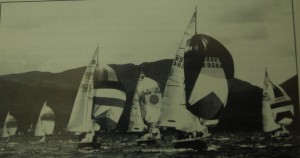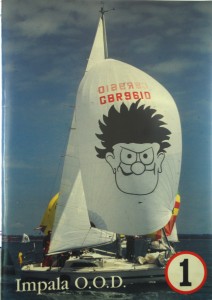Hints from the Past
As True Today as Ever
Tuning and Sailing the Impala
By David Thomas
This article was originally published in the 1996/7 yearbook. Has anything changed? Read on… and feel free to add your comments at the end. Do you ever use your outside cars for upwind sailing any more!
 It is always of interest to study early photographs of One-design classes and compare them with up-to-date shots of the same class. For instance, any similarity between the early Dragon or Soling and a current example of the class will show how much a One-Design can develop after a few years. Mast rake changes, shroud tensions vary, sail design develops, crews learn to carry full sail in higher windstrengths and the boats go faster year by year. The Impala stil has a long way to go along this development course.
It is always of interest to study early photographs of One-design classes and compare them with up-to-date shots of the same class. For instance, any similarity between the early Dragon or Soling and a current example of the class will show how much a One-Design can develop after a few years. Mast rake changes, shroud tensions vary, sail design develops, crews learn to carry full sail in higher windstrengths and the boats go faster year by year. The Impala stil has a long way to go along this development course.
Each owner’s approach to obtaining a competitive level in the class must be based on a set of their own perosnal theories about what makes a yacht sail fast so that they can attain the competitive boat speed to go with tactical skils.
These personal theories must be built up from reading, observation of other competitors’ techniques and, most important, practice and experience – trial and error. They must undergo a constant programme of updating and modification. To put up one’s rig and trim one’s sail without much notion of the basic requirements guarantees a place at the back of the class!
The Impala
It is most important to understand the kind of boat we have in the Impala. She is of light displacement with a slim, easily driven underbody. She is a high-pointing boat and also capable of fast surfing and even planing in smooth water. Like all yachts she likes to be kept on her feet. She has a short, high aspect ratio keel and a rudder of minimum area. Most of her racing is done with a mainsail and either No1 or No2 Genoa. Control of the headsail luff is acheived theough a combination of main shroud tension, main sheet tension and top mast backstay adjustment.
Sailing to windward
The most important technique to master is the art of feathering to windward in strong winds and steep seas. Staying ‘in the groove’ when all the elements are trying to push you out of it! It seems that the crew that can successfully carry the largest possible headsail will win on this score. As soon as headsail size is reduced the boat loses the power to drive through a seaway whilst still pointing high. With a smaller sail she points lower, heels more, makes more leeway, sails a shade faster, is more difficult to steer and is slower getting to the windward mark.
Spinnaker reaching
Another critical control point, as with all light displacement yachts, is when spinnaker reaching in a good breeze. As the windstrength increases, the spinnaker pole must be carried further and further aft to prevent broaching. The yacht may round up occasionally and the spinnaker collapse, but she will be easy to get back on her course. There is no need for broaching – but if you do feel one coming on then several short, sharp tugs on the tiller are a better solution than one stalling, two-handed heave.
Genoa sheeting
The Impala has inboard and outboard genoa sheeting tracks and there is not enough use of the outboard track in steep seas which restrict the pointing angle. Few yachts are perfecting systems for quickly transferring from one track to the other or for combining the two to achieve an even wider variation for windward sailing. Equally when two sail reaching many Impalas are slow to transfer their genoa leads to the outside track.
Rig setup
How should we set up the rig to maximise the effect of these various techniques? It is impossible to be dogmatic because there are some variations in the shapes of mainsails from different sailmakers, but to generalise to some degree:
- The mast must be upright in the athwartships plane. Check this by taking a tensioned main halyard to the same point on the hull on each side of the yacht.
- In the fore-and-aft plane the mast should have an aft rake of 18″ measured at the top of the main boom. To set this rake the crew should be on board to trim the yacht to a horizontal fore-and-aft flotation (sailing trim). The rake can then be checked by hanging a weight on the end of the main halyard just clear of the coachroof and measuring the offset from the back of the mast. Make sure the back stay is slack at the time
- The next move is to basically tension the main and cap shrouds. Before touching anything remember to KEEP COUNT of the number of turns and half turns. Taking two or three turns at a tiume, initially, tighten the cap shrouds until the spreaders push the middle of the mast forward about 3 inches. With the lower shrouds slack, make sure that the mast is straight in the athwartships plane. Next tension the lower shrouds with equal numbers of turns each side to reduce the pre-bend at the middle to 2 inches. Then return to the cap shrouds and, applying equal numbers of turns and sighting up the mast for straightness, tension the caps until the forestay is tightened to the point where standing on the foredeck and holding the forestay at shoulder height it can only be deflected about 1 1/2 inches when swinging your full weight aft. Finally, check the pre-bend and if necessary tighten the lowers again to bring it back to approximately 2″.
- Next, set the topmast backstay until the lever is fully extended upwards with its adjusting purchase released and there is the slightest tension on the backstay. This wil leave the full adjustment available for bending the mast in strong winds to flatten the mainsail.A check at this stage is to hoist the mainsail in a flat calm. Pull down the Cunningham and Flattening reef to their maxima and then bend the mast to the full throw of the lever. The mainsail should be almost totally flat with only a trace of flow just behind the mast.Check the rake and shroud tension often. It will change quickly in the new yacht. Whenever you are moored alongside other impalas check your rake against theirs. Make sure that you are not doing anything radically different from the boats that are sailing fastest. Always KEEP COUNT of turns on rigging. If you lose your place it means starting again from the beginning.
Now it is simply a matter of good sailing and plenty of it – the surest way to success!

1 Comment
Impala 28 Offshore One Design » David Thomas’ hints from the past · March 9, 2011 at 1:14 pm
[…] Hints from the Past by David Thomas […]